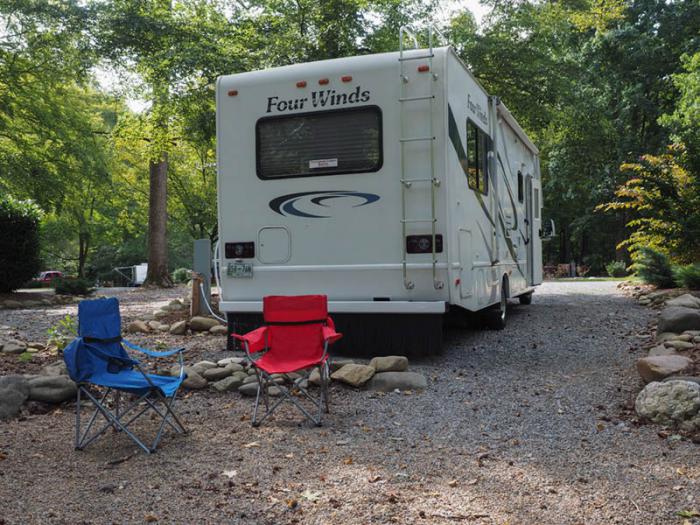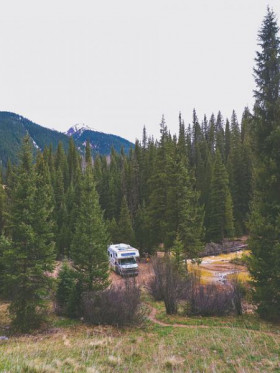The crispness in the early morning air at the Cades Cove Campground assured me that the Great Smoky Mountain National Park was the place to be on this early fall day. The crackling campfire felt good as I savored my surroundings with my hands wrapped around a cup of hot coffee.
There is nothing like a cool morning, and warm campfire, and a cup of hot coffee. Cades Cove is one of ten developed campgrounds contained within the national park. There are over nine hundred developed campsites awaiting the RVer to the most visited national park in the country. There is also a multitude of primitive campsites along the mountain trails.
Our fall trip to the Smokies has become the most anticipated of our annual adventures. Because of the vastness of the park and the always beautiful scenery, we seldom leave without discovering something new about our favorite retreat. With the number of different campgrounds available, we can make our reservations early enough to enjoy the variety of locations. In addition, there are many private campgrounds outside the national park for your RV. Each year we try to investigate a new area of the park.

Last season, we visited the Cataloochee Valley, which is located on the extreme eastern edge of the Great Smoky Mountain National Park. Access to Cataloochee is from Highway 276 off Interstate 40's Exit 20 between Knoxville, Tennessee, and Asheville, North Carolina. The exit is actually in North Carolina. Follow the signs to Cataloochee from Highway 276. The road turns into gravel and ascends through a remote residential area. As the road begins to descend into the valley, it enters the national park and the pavement resumes. Stop at the overlook before entering the Cataloochee valley to get a spectacular panorama.
The Cataloochee Valley contains several preserved buildings. At the turn of the century, there were nearly 200 buildings and it was the largest settlement in the area. Farmhouses, a school, a church, and a few barns remain in this picturesque valley. Because of its remoteness, Cataloochee is not a heavily visited area. That was our latest discovery in the Smokies.
The list of things-to-do in the Smokies is practically endless, from the usual outdoor activities, like hiking, horseback riding, and fishing to taking pictures, watching wildlife, skiing, and visiting the historic and scenic attractions. All quickly become unusual and exceptional with the Smoky Mountains as the backdrop.
Gateway towns
The gateway towns around the park -- Gatlinburg, Pigeon Forge, Townsend, Tennessee, and Cherokee, North Carolina -- serve to enhance the time spent in and around the Great Smoky Mountains National Park, which is the main attraction. Each of these towns has additional campgrounds and attractions that provide visitors with another assortment of activities. Shopping malls, mountain arts and crafts, restaurants of all types, theme parks, live musical entertainment, and children's attractions (go-carts, miniature golf, museums, and game rooms) are available. The chambers of commerce of each town can provide information.
Gatlinburg, Pigeon Forge, and Townsend are all on the Tennessee side of the Smokies. Each has a distinctive atmosphere. Gatlinburg has a national park on three sides and is less than one mile from the entrance to the Smokies. The Sugarlands Visitor Center in the national park is the nearest landmark to Gatlinburg. Over 440 arts and craft and specialty shops featuring mountain and Indian crafts, leatherworks, pottery, local artists' paintings, and photographs await the visitor in Gatlinburg. The top visitor attractions are the Ripley's Aquarium of the Smokies and Ober Gatlinburg. The aquarium is a highly rated and popular attraction. At Ober Gatlinburg, visitors ride a cable car to the mountaintop for the ski resort and amusement park.
The fastest-growing of the towns is Pigeon Forge, which is five miles away from the national park and has attractions geared for all members of the family. Outlet shopping malls. Water parks. Music halls that feature Branson-like shows. Recreation centers. Dollywood and the Dixie Stampede. The Hollywood Wax Museum and the Titanic Museum Attraction.

Townsend boasts of being on the “peaceful side of the Smokies.” It is actually on the same side as Gatlinburg and Pigeon Forge, but it is quieter because of its reduced commercial development. Townsend is two miles from an entrance to the national park. Cades Cove is easily accessible from this entrance to the national park and is only a nine-mile drive from Townsend.

On the North Carolina side of the Smokies lies the gateway town of Cherokee, within the 56,000-acre Cherokee Indian Reservation. Stop off at the Cherokee Visitor Center and the Museum of the Cherokee Indian for the town's attractions and to learn more about the history of this colorful people. Just outside the national park's southern boundary near Cherokee is located the Oconaluftee Indian Village, which is a model village displaying the Indian way of life 200 years ago.
National Park Campgrounds

Within the national park's campgrounds, trailer hookups and showers are not available, however, this is not unusual for the national park system. So, be sure to consider these features upon RV hire. The campground facilities do include flush toilets, running water, picnic tables, and fire grills. Disposal stations are located throughout the national park at various campgrounds (Cades Cove, Smokemont, Cosby, Deep Creek, and at the Sugarlands Visitor Center.) The larger campgrounds have amphitheaters from which park rangers may hold programs like lectures, guided nature walks, or slide shows. Reservations for campsites at Cades Cove, Elkmont, and Smokemont are required May 15 through October 31 and stays are restricted to seven days during this period. During the non-peak season stays of up to 14 days are allowed. Other park campgrounds are on a first-come-first-served basis, but the 14-day length of stay restriction still applies.

Getting to the gateway towns of the Smokies by Interstate 40 from either the North Carolina side or from the Tennessee side is simple. Exit 407 will take the RVer south through Sevierville on Highway 66, then to Pigeon Forge, which is about 14 miles off the Interstate. In Pigeon Forge turning onto Highway 321 will lead to Townsend, about 15 miles to the southwest. If you choose to go to Gatlinburg, continue on Highway 441 through Pigeon Forge following the road signs for another five miles.

Cherokee, North Carolina, is another 35 miles across the mountains from Gatlinburg. Cherokee can also be reached by exiting I-40 at Highway 276 on the North Carolina side at the same Exit 20 as the Cataloochee Valley. You can pop by the famous Mingus Mill, then the scenic Blue Ridge Parkway, which is very close to the town of Cherokee in its route through the extreme southwestern portion of the state and the Nantahala and Pisgah National Forests. This section of the Blue Ridge Parkway is definitely worth a visit, and if your route to the Smoky Mountains could be directed from the east, the journey would be rewarding in scenic beauty.

Our much-anticipated visit to the Smokies each fall is the highlight of our year. Even though we have tried RV hires there for many years, it remains our favorite destination. It is easy to see why it is the most visited national park in the country. It is certainly ours.




